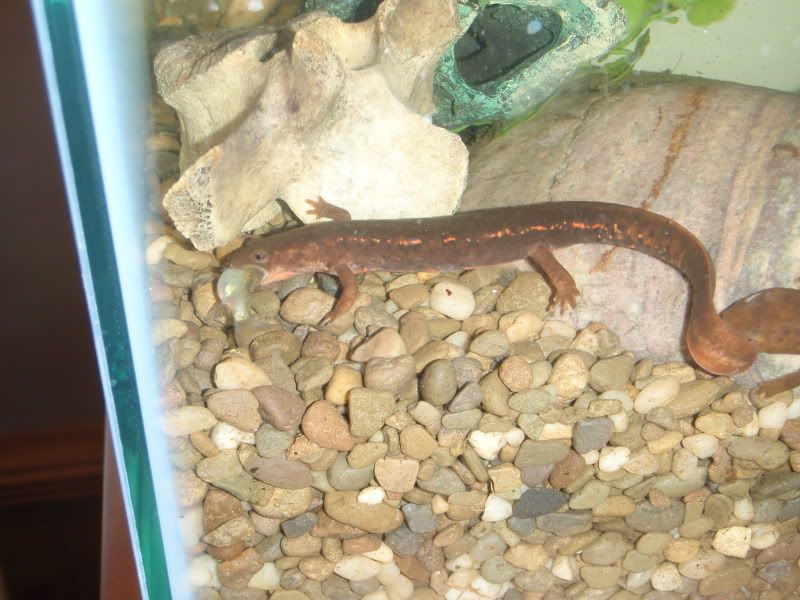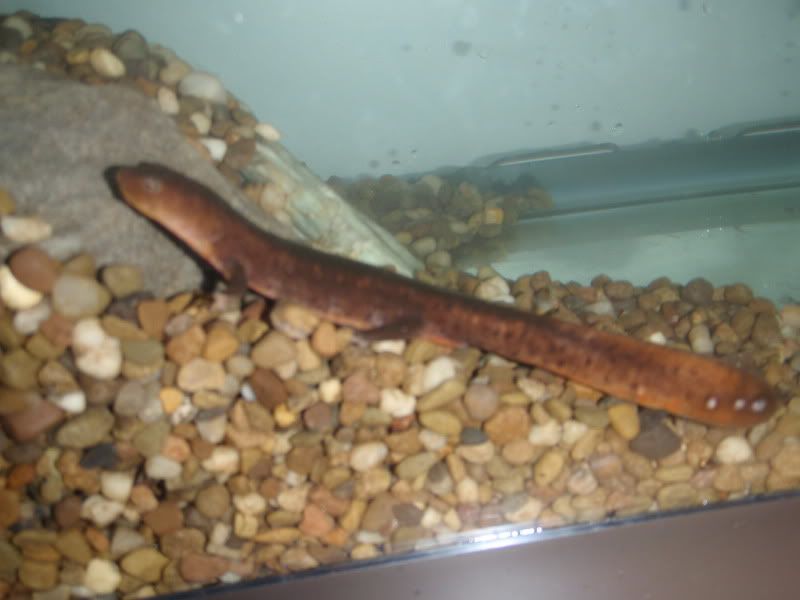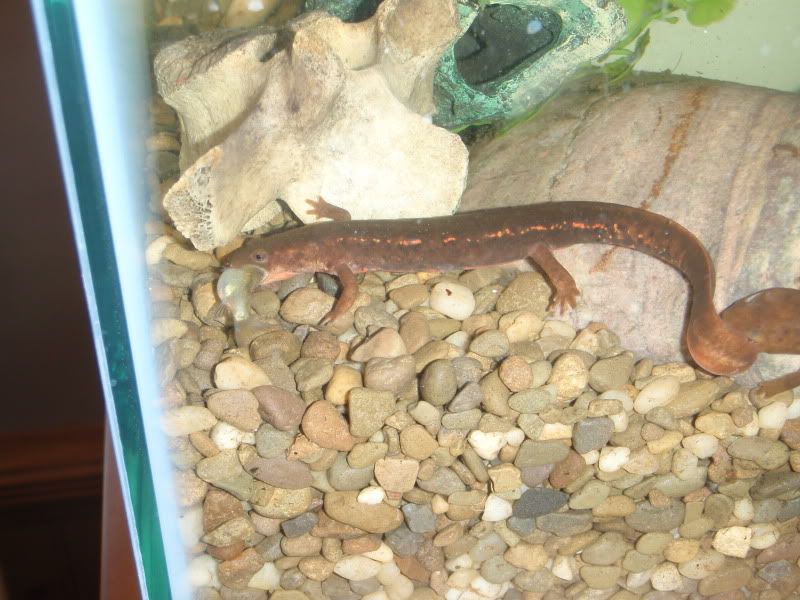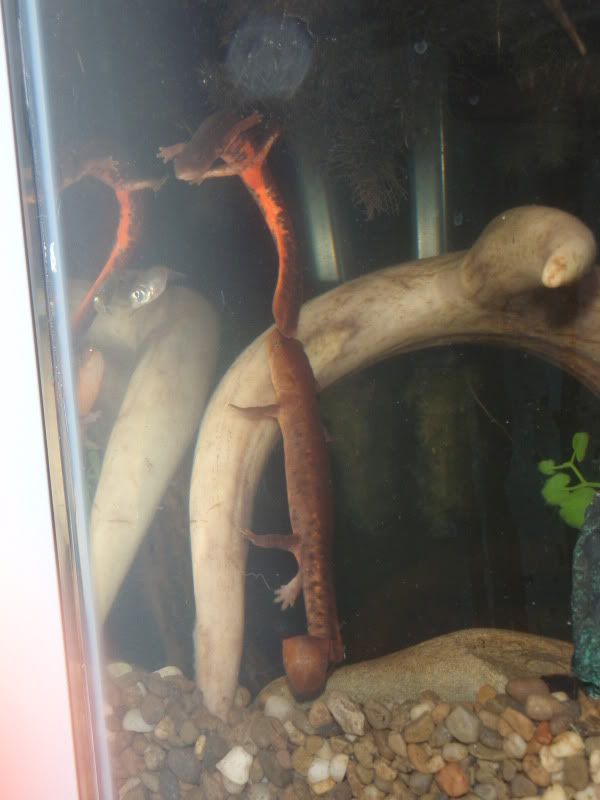The one that is in the pic has a far narrower head than all the others in the tank and is from not only a different import batch but a different store. She also is more active and has a narrower tail, as well as different colored eyes (which I know means nothing but is fun to point out). She is also less bulky and the only one that catches fish or shows interest in the shrimp.
Both
P.granulosus. The other species are overall much more robust - heavier and longer legs, wider heads, heavier bodies. The animals pictured above are also fairly "normal" color for
P.granulosus.
It wouldn't shock me if they have a complex going on, if the appalacians teach us anything it's the caudates are hideously brutal in that regard. I'd actually be more shocked if there WASN'T something screwy going on with them.
Whole different situation. In Appalachia, we have an incredibly ancient mountain system which is a holdover from the original origins of salamanders over 200 million years ago. Most significantly, most of the diversity we see in the region is in two genera:
Plethodon and
Desmognathus. The former is a highly sedentary direct developer - it's prone to speciation because it rarely moves more than a couple feet from its home, and it has a limited range of habitat tolerance. As climates shift, populations expand and contract and lead to profuse speciation.
Desmognathus are mainly stream dwellers. They're a little better at migrating, but that will often be along the length of stream systems. Speciation will largely derive from changes in direction of stream flow [interconnecting and dividing drainages] and the competition that derives from secondary contacts.
In
Pachytriton, we have a younger genus of stream-dweller. It hasn't had the amount of driving factors for speciation as the plethodontids have. The driving factors have instead led to the origin of habitat-specific genera [
Hypselotriton, Laotriton, Paramesotriton, Pachytriton], with only the most volatile habitats having a lot of speciation. That is, the mid-altitude step-pools -
Paramesotriton. In any event, there just isn't evidence of great diversification in
Pachytriton. Four species have been named, and morphology, genetics, and geography all identify three distinct clades conforming with these. One of those clades has three distinct branches, two of which clearly conform with known species. So, while there IS evidence of cryptic species, it's nowhere near the scale seen in Appalachian Plethodontidae.
Subspecies typically represents an isolated group that has differences but could still be considered the same species as far as I know; things like island populations are fantastic examples, assuming they've been separate for long enough to have some drift.
Although true, that kinda misses my point. Note the portion I've bolded. Species and subspecies
are defined exactly the same way. The part in bold is totally arbitrary and subjective. Although there are many definitions for a species [typically, when one works, many do], those definitions depend on objective criteria to conclude "these are the same" or "these are different".
Classically, subspecies have been recognized when a diverse population is found to have physical differences from one part of the range to others, but with those differences merging gradually. Problem number one - if they merge gradually, then they interbreed freely and are not distinct at all - no subspecies should be recognized [see also
Liochlorophis vernalis]. Problem number two - the traits used to identify subspecies, have often not co-varied with other traits. Again, no subspecies. Third problem - with increased sampling, it is often found that there is no distinct merger - either very similar organisms overlap in range and create an illusion of intergradation, or two or more very similar organisms replace one another, again with no actual merging of traits. To this third problem, the conclusions is "species", since each group of organisms is biologically and functionally independent, regardless of how long or sharp that distinction is. Consequently, subspecies are rarely recognized any more.
I think there is significant differences, moreso than would be allowed within the typical "morph" framework that herpetoculture uses.
Herpetoculture is not exactly a great place to look for standards of species recognition or identification. In point of fact,
P.granulosus is the most variable member of the genus. It varies not only by location [with most departures from the norm being from the southern edge of the range, adjacent to
P.brevipes], but by age. Both have been enormous causes for problems, most notably being the description of a new genus based on juveniles, the resurrection of that genus, and the combination of that genus with the Chinese fire-bellies - all because the animals change so much as they grow.
Edit: frog eyes, do you frequent the ERAS forums as well?
Yes.
Maybe we should talk in PM about salamander and caecillian phylogeny, as they might not be true lissamphibians.

Such a discussion would be inaccessible to most who might wish to learn from it or share in it

In any event, the case for Gymnophiona and Caudata forming a clade independent from Anura is far from a strong one. For instance, the majority of data, including genetic, clearly show Caudata to be sister to Anura, to the exclusion of Gymnophiona. No amount of fossil interpretation can lead to salamanders and caecilians being sister groups, if the genes have already shown that this is impossible.










